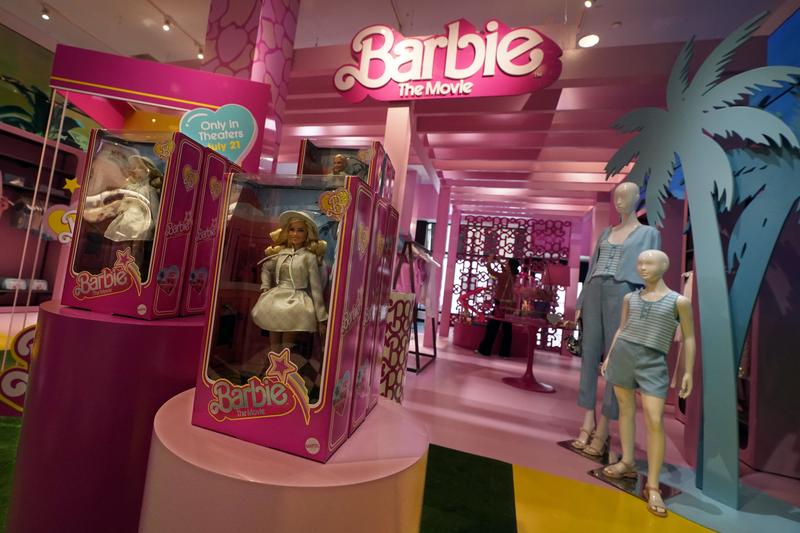Barbie on the Big Screen (And Your Childhood)

( Richard Drew / AP Photo )
[MUSIC]
Brian Lehrer: Today Barbie hits theaters nationwide after limited releases elsewhere, so we're going to open up the phones right away. I don't know if we have anybody yet who's seen the movie in those limited-release markets. If so, how'd you like it? What did it mean to you? 212-433-WNYC. Or if you haven't yet, but intend to, what are you most looking forward to? Anybody dressing up and going all out for this one?
For everyone else, if Barbie has been a presence in your childhood or adult life, what ways has Barbie impacted you? Any kids listening who want to have their parents call up? Go tell your mom, dad, “Call the Brian Lehrer Show.” Do kids still play with Barbie these days? Whether it was her multitude of professions that had a positive impact or her unrealistic proportions that had a negative impact, do you have a conflicted relationship with Barbie? You can text or call us, 212-433-WNYC, 212-433-9692.
Joining us to explain some of the cultural significance of Barbie's history and why she's been so controversial at times is Tanya Lee Stone, who runs the writing program at Champlain College in Vermont, and is author of several books including The Good, the Bad, and the Barbie: A Doll's History and Her Impact on Us. Professor Stone, thanks for doing this with us on release day. Welcome to WNYC.
Tanya Lee Stone: Thanks so much. Thanks for having me.
Brian Lehrer: In your book, you've written about the history of Ruth Handler who co-founded Mattel with her husband, Elliot Handler and Harold Matson in 1945. There are a couple of versions of the creation story of Barbie. In one, Ruth noticed her daughter, Barbara, playing with paper dolls and imagining herself as an adult. Can you tell us briefly about how Barbie was born out of that, and Ruth's intention for creating the doll, the reason behind it?
Tanya Lee Stone: Yes, absolutely. May I just say, I love how you open your show up to people calling in because that's exactly what I did for this book. I wanted to hear from people in general, so I solicited anecdotes. About 500 people responded because as we're seeing, this is a doll, a plaything, 11.5 inches of plastic that really sparks a lot of different kinds of conversations.
The origin story as I know it to be true, is exactly what you were bringing up. Ruth and Elliott had founded Mattel in 1945, and in the mid to late ‘50s, Ruth's daughter Barbara was getting to be the age where she was growing out of baby dolls that were one of the two primary dolls available to girls at that time. The girls, Barbara, and her friends, didn't want to play mama anymore to their baby dolls, and the other form of doll that was readily available were the paper dolls, where girls could change the outfits, pretend to be things, and there's where you start to get the hint of Ruth's initial intention. She watched this play experience and thought, "Wow, if I can three-dimensionalize this play experience, I'll have something really special."
Brian Lehrer: The first model went on display in March of 1959, I see at the annual Toy Fair, here in New York City and the industry at the time was skeptical that children would want to play with an adult doll. Take us back to that moment. What was the toy market like? You just alluded to some of it, but what were some of the marketing challenges that Ruth Handler had to navigate?
Tanya Lee Stone: Right. Well, it's true. Some of the marketing challenges that Ruth had to navigate were within Mattel itself, including her very husband and co-founder. She had envisioned this very va-va-voom doll, shall we say, that really to her was all about being a teeny tiny mannequin because, for Ruth, it was all about the clothes. Even Elliot thought she had gone too far and didn't think that adults would buy dolls for children that had breasts. Ruth's take on that was, "I want them to imagine being grown-up women and grown-up women have breasts." She didn't see what the big fuss was about.
I thought that that was very interesting. She stood her ground as she always did because the one thing that Ruth was all about was tell her something was impossible, and she was going to prove you wrong.
Brian Lehrer: Yes, but the proportions have drawn decades and decades of blowback around realistic physical proportions spawning how many eating disorders and gender stereotypes. Famously in 1992, Teen Talk Barbie mechanically said, “Math class is tough,” which drew a lot of negative comments for obvious reasons.
Tanya Lee Stone: That's right. Barbie has been a real Pandora's Box as it turns out, and it's received tons of flack on many, many fronts. That particular sentence, the Teen Talk Barbie sentence, “Math class is tough,” that was one of the things that inspired a group called the BLO, the Barbie Liberation Organization, which was a fascinating group. It was a guerrilla marketing action.
What they did was they switched out the voice boxes between GI Joe and Barbie in a whole bunch of toy stores throughout the country. I think in reality, they only changed out 75 to 100, but they put out the news that they had changed out hundreds of them to get the frenzy going. I loved that they did that. It's just another point of conversation and controversy. I think in general, Mattel has done some things really smartly and well to move things forward, that reflect different things in culture, and also two steps forward, one step back.
Brian Lehrer: Lisa, in White Plains, you're on WNYC. Hi, Lisa.
Lisa: Hi, Brian. Thanks for having me. I just wanted to say now I'm in my 30s, but I played with Barbies a lot as a kid. I was always very into theater, and acting, and drama even as a young kid, so playing with Barbies was a way for me to act out certain situations, and be dramatic, and have these spicy situations. I also used to cut the hairs off the dolls and color them with lipstick. It was a way for me to express myself, get some anger out maybe, so yes.
Tanya Lee Stone: That's great. I did a whole chapter in this book on Barbie bashing.
Brian Lehrer: Uh-huh?
Tanya Lee Stone: People's anecdotes about that are fascinating.
Brian Lehrer: Ciara in Atlantic Highlands has already seen the movie. Hi, Ciara, you're on WNYC.
Ciara: Hi, yes. I got to see it yesterday in the afternoon with my husband in a theater full of people decked out in pink and it was a really fun environment to be in. My favorite part was absolutely the amount of families, particularly mothers and daughters who were going out to see this movie together on a random Thursday. And yes, myself and my husband were both decked out in pink.
Tanya Lee Stone: Love it.
Brian Lehrer: Have you seen it yet yourself?
Tanya Lee Stone: I have not. I'm seeing it tonight with a group of friends. I'm really looking forward to seeing what Greta Gerwig has done with this topic. I've read some interviews with her. I'm a fan of her work in general. She and I seem to be very much on the same page in terms of, you have to lean into this whole thing and see all sides of it, which is why I called the book The Good, the Bad, and the Barbie. There's no getting around the fact that there are pros and cons of this plaything.
Brian Lehrer: Ciara, did you get a sense that this was a Mattel film designed to sell toys, or a Greta Gerwig film designed to say something worth saying, or a combination of the two?
Ciara: What an interesting question. I don't want to give away any plot but I think it definitely leans more towards the Greta Gerwig of it all. The script was written by Greta Gerwig and Noah Baumbach, who have a very kind of sardonic inner New York kind of storytelling usually, so we went in completely unsure which side it would fall on. I think we came out-- We were laughing so much. It definitely felt like the Greta Gerwig film, but it was clear Mattel was at least involved let's say.
Brian Lehrer: Thank you, Ciara. Thank you very much. Sebora in Manhattan, you're on WNYC. Hi, Sebora.
Sebora: Hi. Two things, I definitely played with Barbie. My mother gave me the theater. This is in the early ‘60s. I am a playwright and director, so I had no idea I would actually do this, but I used to play with Barbie and with this paper theater. The other thing I wanted to say was when I was a little girl, so I'm in my 60s now, there were no Black Barbies. I took my Barbie and Ken and I painted them with brown shoe polish. I dressed them up as Pharaoh and Queen Cleopatra.
Tanya Lee Stone: Wow.
Sebora: I made their outfits and I did it myself because I wanted a Brown Barbie. My granddaughter now has Brown Barbies in all different shades with different hair textures, and they even have Barbie with big hips.
Brian Lehrer: Yes, talk to us Sebora, because then eventually, and I think it sounds like Sebora beat them to it, there were official Black Barbies, right?
Tanya Lee Stone: There were, yes. It's an interesting-- Sorry.
Sebora: The other thing, the bad thing, or-- well, maybe not bad because at least now we have multicultural Barbies, but there were independent Black toy companies that started making these dolls that reflected the Black community. I think Mattel jumped on that when they realized, "Oh, we have neglected people who buy dolls for their kids."
Brian Lehrer: Absolutely. Yes. Too bad you couldn't have patented what you informally designed there, gotten in on the profit. Sebora, thank you so much. Part of the history that you tell in your book Professor Stone is that in 1968, same year as the Fair Housing Act, Mattel introduced Christie, a Black doll with "a mod swimsuit" according to the Smithsonian’s description, but she wasn't Black Barbie per se, just a part of the Barbie universe, right?
Tanya Lee Stone: Right. This is actually a really interesting history and Sebora touched on it a little bit. The first Black Barbie doll was Francie in 1967, which was a Black version of the white Francie. Around the same time, actually, a year prior, Elliot Handler loaned money and his expertise to a nonprofit Black-owned toy company called Shindana, which was making what were then called multicultural dolls. Meanwhile, Mattel's Black Francie didn't do very well.
A year later, they put out a Black Christie doll, who was Barbie's friend. It wasn't until 1980 that Mattel put out both Black and Hispanic dolls that weren't just friends of Barbie, they weren't just in the Barbie universe, they were Barbies. There's a documentary out now on the festival circuit that I can't wait to see when it's more widely available by filmmaker Lagueria Davis. I was on a show with her yesterday and learned all about this. The story was inspired by Lagueria's aunt who actually worked on the first Barbie production line and was later involved in conversations at Mattel about Black Barbie.
Brian Lehrer: By the way, a listener texts, "My mother, being very forward-thinking, bought me a Barbie. I absolutely loved playing with it, but as a young boy knew that or felt that it was something I should hide.” How about boys in Barbie? Anything on that in your book?
Tanya Lee Stone: Not really, except for the boys who wrote into me and shared their personal stories. There wasn't a ton of research about this 13 years ago when I first wrote the book.
Brian Lehrer: One more call. How about Jennifer in West Milford in Jersey? You're on WNYC Jennifer, we got about 30 seconds for you. Hi.
Jennifer: Hi. I just want to say, when I was a kid, I was a tomboy, did not play with Barbies. Had a daughter, decided I was going to let her choose and not put that same thing on her. Went to the store to buy a Barbie and found nothing but the curvy tight clothes had a meltdown saying, "Why don't they have tomboy Barbie, something that I can identify with, my daughter can identify with?" I did not get her a Barbie. I got her some other dolls. She ended up not playing with dolls any more than I did. She was a stuffed animal girl like I was, but I was really freaking out in the store thinking they really need to have a different type of Barbie for different types of kids.
Brian Lehrer: Jennifer, thank you. Thank you very much. 10 seconds. Last word, Professor.
Tanya Lee Stone: Ah, I see. Well, I really related to that last caller because I also didn't play with dolls when I was little. I identified as a tomboy. I think that in all of the conversations that we can have about Barbie, pro and con, empowering or does she make us feel inferior about ourselves, what I took away the most from my research and from writing this book was that what we bring to the doll, what our lived experiences is what we take away.
Brian Lehrer: There we go with the Barbie movie debuting with Tanya Lee Stone who runs the writing program at Champlain College in Vermont and is author of The Good, the Bad, and the Barbie: A Doll's History and Her Impact on Us. Thank you so much.
Tanya Lee Stone: Thanks for having me.
Copyright © 2023 New York Public Radio. All rights reserved. Visit our website terms of use at www.wnyc.org for further information.
New York Public Radio transcripts are created on a rush deadline, often by contractors. This text may not be in its final form and may be updated or revised in the future. Accuracy and availability may vary. The authoritative record of New York Public Radio’s programming is the audio record.

